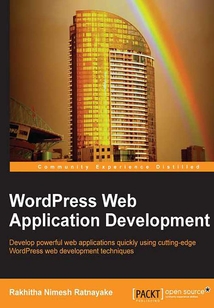舉報 

會員
WordPress Web Application Development
最新章節(jié):
Index
Anextensive,practicalguidethatexplainshowtoadaptWordPressfeatures,bothconventionalandtrending,forwebapplications.ThisbookisintendedforWordPressdevelopersanddesignerswhohavethedesiretogobeyondconventionalwebsitedevelopmenttodevelopqualitywebapplicationswithinalimitedtimeframeandformaximumprofit.Experiencedwebdeveloperswhoarelookingforaframeworkforrapidapplicationdevelopmentwillalsofindthistobeausefulresource.PriorknowledgewithofWordPressispreferableasthemainfocuswillbeonexplainingmethodsforadaptingWordPresstechniquesforwebapplicationdevelopmentratherthanexplainingbasicskillswithWordPress.
目錄(108章)
倒序
- 封面
- 版權(quán)信息
- Credits
- About the Author
- About the Reviewers
- www.PacktPub.com
- Preface
- Chapter 1. WordPress As a Web Application Framework
- WordPress as a CMS
- WordPress as a web development framework
- Simplifying development with built-in modules
- Identifying the components of WordPress
- A development plan for a portfolio management application
- Understanding limitations and sticking with guidelines
- Building a question-answer interface
- Summary
- Chapter 2. Implementing Membership Roles Permissions and Features
- Introduction to user management
- Getting started on user roles
- Understanding user capabilities
- Registering application users
- Implementing the frontend registration
- Creating a login on the frontend
- Time to practice
- Summary
- Chapter 3. Planning and Customizing the Core Database
- Understanding the WordPress database
- Exploring the role of existing tables
- Adapting existing tables into web applications
- Extending a database with custom tables
- Planning the portfolio application tables
- Querying the database
- Limitations and considerations
- Summary
- Chapter 4. The Building Blocks of Web Applications
- Introduction to custom content types
- Planning custom post types for the application
- Implementing custom post types for a portfolio application
- What is a template engine?
- Persisting custom field data
- Introduction to custom post type relationships
- Pods framework for custom content types
- Time to practice
- Summary
- Chapter 5. Developing Pluggable Modules
- A brief introduction to WordPress plugins
- WordPress plugins for web development
- Time to practice
- Summary
- Chapter 6. Customizing the Dashboard for Powerful Backends
- Understanding the admin dashboard
- Customizing the admin toolbar
- Customizing the main navigation menu
- Adding features with custom pages
- Using feature-packed admin list tables
- An awesome visual presentation for the admin dashboard
- The responsive nature of the admin dashboard
- Time for action
- Summary
- Chapter 7. Adjusting Themes for Amazing Frontends
- Introduction to a WordPress application's frontend
- Template execution process of web application frameworks
- Web application layout creation techniques
- Building a portfolio application's home page
- Widgetizing application layouts
- Creating a custom template loader
- Designing the home page template
- Generating an application's frontend menu
- Creating pluggable and extendable templates
- Extending the home page template with action hooks
- Planning action hooks for layouts
- Time for action
- Summary
- Chapter 8. Enhancing the Power of Open Source Libraries and Plugins
- Why choose open source libraries?
- Open source libraries inside the WordPress core
- Open source JavaScript libraries in the WordPress core
- Using PHPMailer for custom e-mail sending
- Implementing user authentication with Opauth
- Using third-party libraries and plugins
- Time for action
- Summary
- Chapter 9. Listening to Third-party Applications
- Introduction to APIs
- WordPress XML-RPC API for web applications
- Building the API client
- Creating a custom API
- Integrating API user authentication
- Integrating API access tokens
- Providing the API documentation
- Time for action
- Summary
- Chapter 10. Integrating and Finalizing the Portfolio Management Application
- Integrating and structuring a portfolio application
- Restructuring the custom post manager
- Integrating a template loader into the user manager
- Working with a restructured application
- Updating a user profile with additional fields
- Scheduling subscriber notifications
- Lesser-known WordPress features
- Time for action
- Final thoughts
- Summary
- Appendix A. Configurations Tools and Resources
- Configure and set up WordPress
- Open source libraries and plugins
- Online resources and tutorials
- Index 更新時間:2021-07-23 15:23:11
推薦閱讀
- 社交網(wǎng)絡對齊
- 物聯(lián)網(wǎng)工程規(guī)劃技術(shù)
- C++黑客編程揭秘與防范
- 物聯(lián)網(wǎng)安全與深度學習技術(shù)
- Learning QGIS 2.0
- 物聯(lián)網(wǎng)+BIM:構(gòu)建數(shù)字孿生的未來
- 信息通信網(wǎng)絡建設安全管理概要2
- 網(wǎng)絡安全技術(shù)與解決方案(修訂版)
- Learning Swift(Second Edition)
- 6G新技術(shù) 新網(wǎng)絡 新通信
- 光纖通信系統(tǒng)與網(wǎng)絡(修訂版)
- 6G:面向2030年的移動通信
- 網(wǎng)絡綜合布線(第2版)
- 深入理解Nginx:模塊開發(fā)與架構(gòu)解析
- 計算機網(wǎng)絡技術(shù)
- 物聯(lián)網(wǎng),So Easy!
- 互聯(lián)網(wǎng)心理學:新心理與行為研究的興起
- 現(xiàn)場總線與工業(yè)以太網(wǎng)及其應用技術(shù)(第2版)
- Learning IoT with Particle Photon and Electron
- 天下一家:網(wǎng)絡聯(lián)通世界(科學新導向叢書)
- 零距離接觸物聯(lián)網(wǎng)
- 邊做邊學物聯(lián)網(wǎng)技術(shù)
- 內(nèi)容分發(fā)網(wǎng)絡(CDN)關鍵技術(shù)、架構(gòu)與應用
- Moodle for Mobile Learning
- Go Web Development Cookbook
- Learning iBeacon
- The Agile Developer's Handbook
- 計算機網(wǎng)絡原理與應用(第2版)
- Flask Framework Cookbook(Second Edition)
- 物聯(lián)網(wǎng)服務平臺技術(shù)

